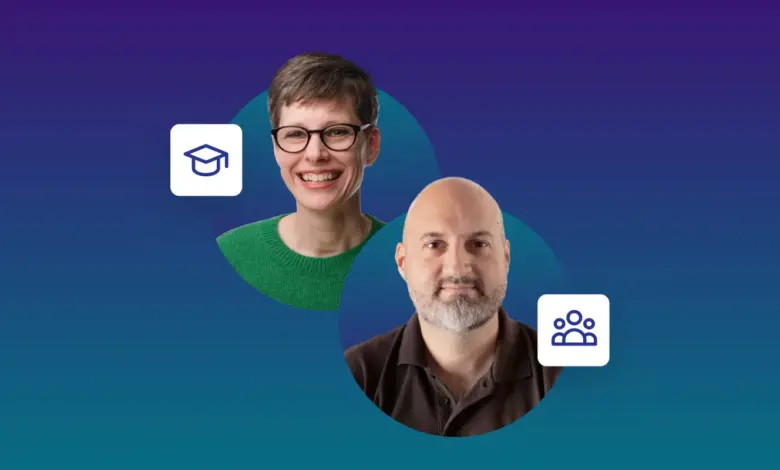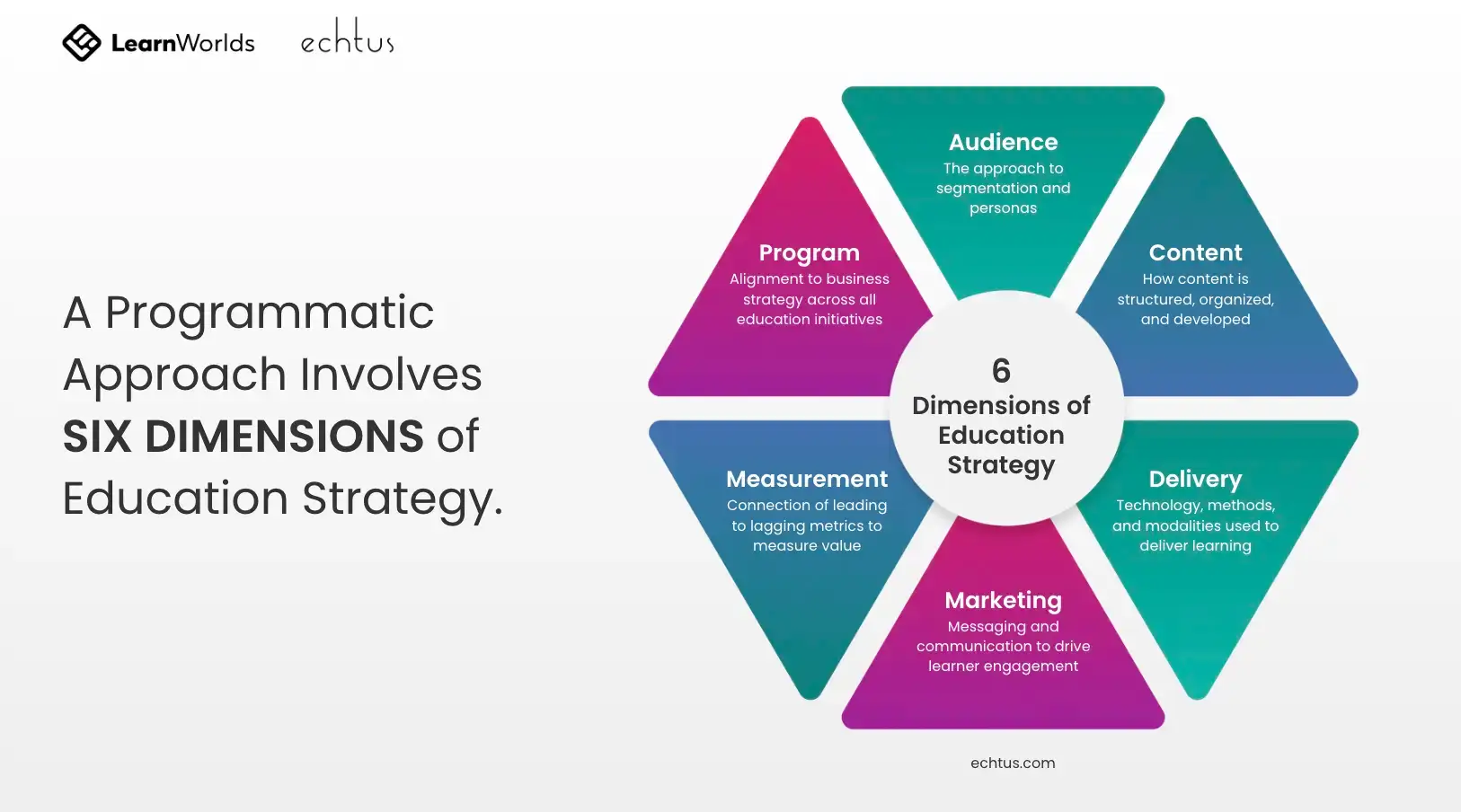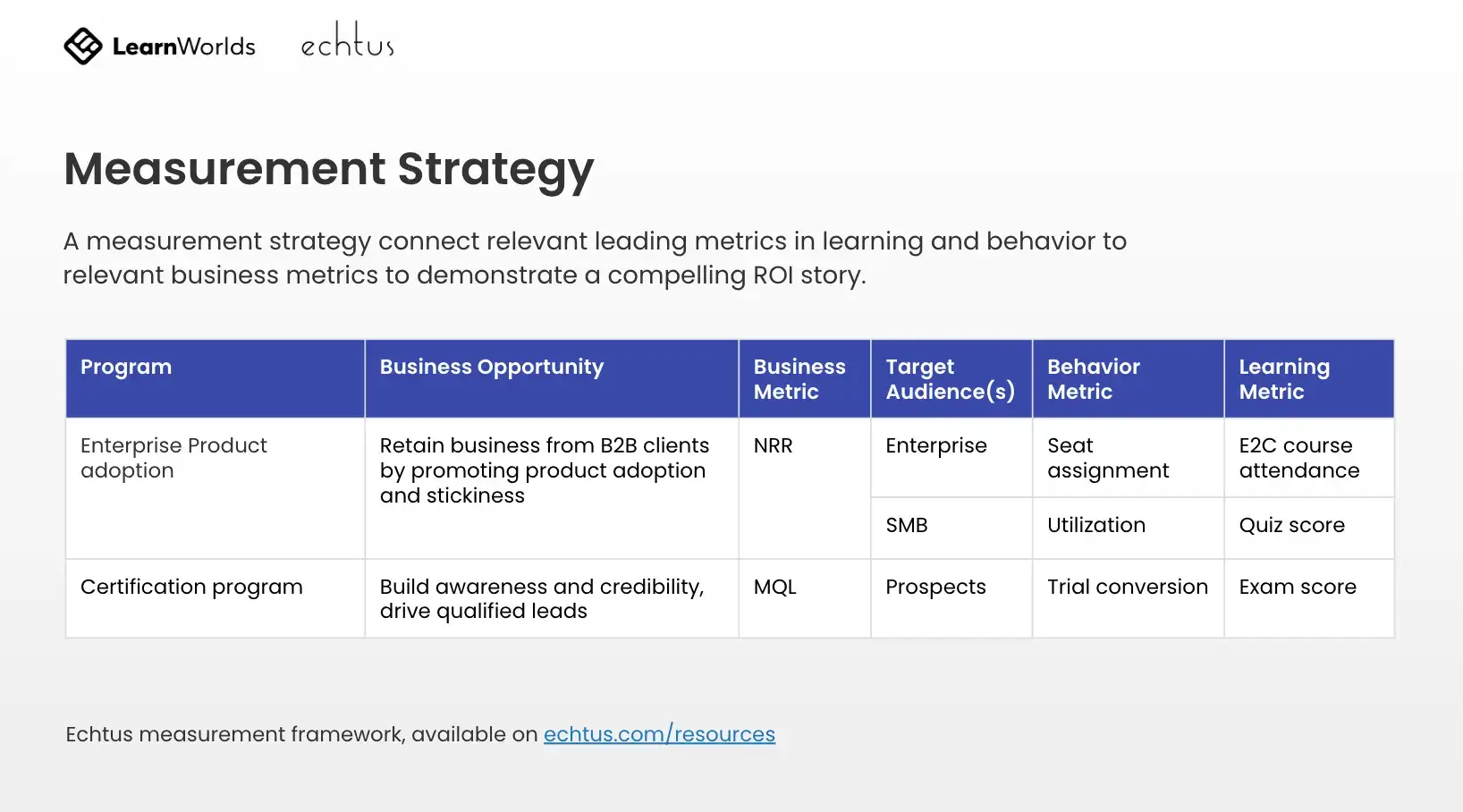Maximize the Business Impact of Customer Training (Webinar Insights)

In a recent webinar, we had the pleasure of welcoming Vicky Kennedy, CEO of Echtus and customer education expert, alongside Panos Siozos, CEO of LearnWorlds. They shared proven strategies for the successful implementation of a customer education program. Vicky also introduced her measurement framedesigned to demonstrate the tangible impact of such programs.
The webinar was a great success and we are happy to have been able to answer so many of your questions and help you delve deeper into the topic.
Don’t miss the opportunity to transform your customer education efforts. Watch the webinar on-demand and get insights that will help you achieve real results!
In the meantime, here’s a quick recap of what we covered:
You may have heard of customer enablement, customer trainingproduct education or product training – they all refer to the same thing. Customer education originated a few decades ago and has evolved from the concept of teaching your customers how to use your tools to what it is today.
The term “customer education” has two meanings:
This is an initiative within a customer success department similar to customer service, customer support and customer relations; it is built to serve existing customers.
Or, it may refer to an initiative where the term “customer” includes not only existing/paying customers, but also potential customers.
Regardless, customer education has multiple advantages and can generate a wide range of results that elevate a business.
Product-centric education versus other learning initiatives
Of course, customer education isn’t the only type of education a company offers. In-company training can take different forms:
✅For compliance: linked to audit and law training and involves departments such as IT and human resources.
💡As a service: product training sold to the customer, i.e. generate incomelike a paid webinar.
🎯As a strategy: When you use training and its results to achieve other business goals, such as increasing customer retention/performance or reducing costs.
When using education as a strategy, you expect a return on investment from these results. It is a more nuanced initiative and it is complicated to measure the results.
The disconnect between business strategy and customer education is one of the biggest problems. common mistakes.
When using customer education as a business strategy, you must be aware and understand your company’s current strategies. That’s why it’s important that the people leading customer training initiatives are integrated with department leaders across the organization.
For example, your business is looking to expand into a new market. How can education achieve this? Understanding the business objectives and the strategy behind these objectives is essential and mandatory to maximize the business impact of customer education.
👉Very often we see companies focusing on content creation and creating multiple courses to cover every possible topic and feature. Although there is nothing wrong with creating content, content alone will not drive the desired business results.
It is important to have a customer education program to ensure that the right people are informed about the right things and for the right reasons; it is also the key to measuring success.
Examples of educational programs:
Sales Enablement Certification Integration Help Center “New Friday Feature”
The six dimensions of a customer education strategy
According to Vicky, a well-orchestrated customer education strategy has the following six dimensions:

Program
All educational initiatives should be aligned with your business strategy. Take inventory of any opportunities or issues you need to address in your organization (e.g. early customer churn); if you want to measure business impact, you need to know what you want to have an impact on!
Prioritize the most impactful initiatives and take stock of the content you already have.
Audience
Even within your customers, you will have different audiences/segments. Make sure you understand their motivations, prior knowledge, challenges, and why they would want to learn from you for a more focused and effective program.
Content
After understanding the first two dimensions of your strategy, you can move on to content creation. While you can use content you already have, your content strategy should be developed taking into account your business strategy and audience.
Delivery
Program delivery is not just about technical toolsas customer training software you will use to deliver your program, but also the modality, for example ILT (instructor-led) or self-paced.
A common mistake for many organizations is to skip the first steps and choose technology tools without having a clear idea of what they want to do.
Marketing
You need to focus on education marketing and connect the audience of learners to learning using their goals and motivations. The goal of marketing is to generate engagement and traffic to your learning program. Without marketing, you won’t get the results you want.
Measures
Measuring the business impact of customer education is absolutely necessary. It helps to have a proactive approach to measure business impact, for example by using a measurement frame like the one Vicky built.
A measurement strategy connects key metrics (learning and behavior) to relevant business metrics (lagging metrics, like NRR) to demonstrate a convincing return on investment.
Key indicators demonstrate engagement in learning. When measuring learning, the organization often relies on those engagement metrics that are easier to obtain and understand, such as completion and participation rates.
👉But if you measure only engagement metricsalthough they are extremely important, it is difficult to demonstrate commercial impact.
The following framework takes a programmatic approach and consists of both leading and lagging measures:

So, based on the framework above, let’s say you have an “enterprise product adoption” program. The program is linked to a commercial opportunity aimed at retaining B2B customers by driving product adoption and sustainability.
How will you measure the success of the training program at the company level?
In this case, your high-level business metric is NRR (Net Revenue Retention) – this is what you will present to management to prove the value of your program.
You also need to divide your target audience, B2B, into specific segments – in this case, enterprises and SMEs.
And how will you know that learning is actually happening?
You can measure learning using engagement metrics, like participation rates or quiz scores, or even gamification. You can then relate them to the behavior metric (because ultimately, learning is about changing behavior!).
In this case, if you are trying to drive usage (= product adoption and sustainability), you can tie quiz results to usage. And usage, in turn, impacts your NRR.
Measures that can translate into revenue are easier for managers to understand. It will also be easier for you to highlight the impact of your program and even request more resources.
Even if you’re sitting earlier in the funnel, you still need to measure something to demonstrate the impact of your program, such as feature usage.
Closing out our webinar, we mentioned the most important pillars you should focus on when creating your program. Keeping these pillars in mind, you can also select a suitable customer training platform:
👥Commitments and community to facilitate interaction, collaboration and peer learning
🤖AI help for a more efficient experience
🎯User management to segment learners and deliver a more personalized learning experience
🎨Branding and personalization to highlight your brand identity and provide a consistent user experience
📱Mobile app improve accessibility on the go to drive engagement and participation
💰Monetization Options because, at some point, you may want to generate revenue through customer training or sell certification programs.
Learn the worlds is a top choice for customer training, offering features like an advanced AI assistant and built-in content creation tools for rapid course creation (including assessment and certificate creators), a Website builder and white label mobile apps, interactive learning activities and integrated tools. community.
Our platform also makes user management easier with access controls, user groups, tagging, bulk and automated actions, and more options. As for monetization, you will find all the tools you need to promote and sell your program, either built-in or as an integration.
More than 9,000 brands trust LearnWorlds to train their employees, partners and customers.
Moving forward
Customer education is a powerful tool that can transform your business. This goes beyond just providing content; it strategically aligns with your business goals to drive measurable results such as increased retention, improved product adoption and greater customer satisfaction.
By leveraging a well-designed educational program and implementing a solid measurement framework, like the one shared by Vicky Kennedy, you can prove the tangible impact of your efforts. Start building or refining your customer education strategy today and unlock its full potential!
Further reading might interest you:
(Visited 143 times, 1 visits today)
Androniki is a content writer at LearnWorlds and shares instructional design and marketing tips. With solid experience in B2B writing and technical translation, she is passionate about learning and disseminating knowledge. She is also a budding yogi, an avid reader, and a talented transponder.




